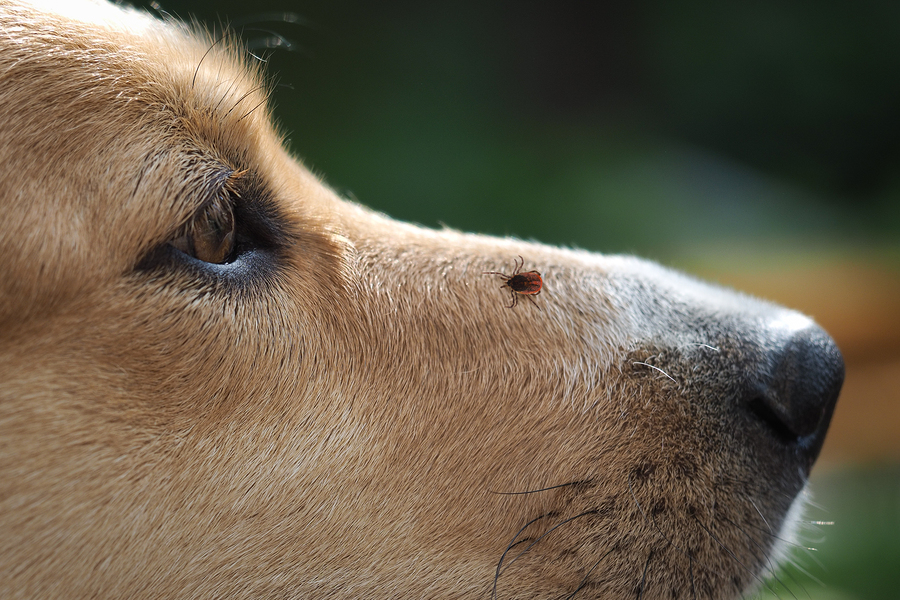Though they’re known to carry serious diseases, not all ticks transmit disease. In fact, many ticks carry no diseases. However, the threat of disease is always present with ticks, and these risks should be taken seriously. The good news is that most tick-borne diseases aren’t transmitted immediately, so if you get ticks off your dog within 24 to 36 hours of a tick bite, your dog is less likely to get infected.
Let’s talk about how to prevent ticks in the first place, remove them safely and disease symptoms to keep an eye out for.
The symptoms of most tick-borne diseases include fever and lethargy. Some tick-borne diseases can also cause weakness, joint swelling and/or anemia, and lameness. Keep in mind that signs may take days, weeks, or months to appear.
Some ticks can cause a temporary condition called tick paralysis, which causes difficulty walking that may develop into paralysis. These signs typically begin to resolve soon after the tick is removed.
If you notice these or any other signs of illness in your dog, contact your veterinarian as soon as possible and get started with proper testing.
Some known tick-borne diseases:
- Lyme disease
- Ehrlichiosis
- Rocky Mountain spotted fever
- Babesiosis
- Bartonella
There’s also an emerging disease that’s quite rare, but worth mentioning, because it isn’t spread by a tick bite, but by dogs ingesting infected ticks.
It’s known as American canine hepatozoonosis (ACH) and can be a highly debilitating disease so it’s especially important to remove ticks from your dog before they do it themselves.
ACH is found in the south central and southeastern US.
Removing Ticks From Your Dog: Dos and Don’ts
Do: Remove ticks as soon as possible: before 24 to 36 hours of a bite.
Do: Check your dog thoroughly. Ticks especially like to attach themselves in places like the groin, between toes, in or around the ears, around the anal area, tail and eyelids.
Do: Use a tick removal tool. I personally recommend the Tick Twister (shown below).
Don’t: Squish or crush a tick. This can force infected body fluids through the tick’s mouth and into your dog, and increase the risk of infection.
Don’t: Put substances like nail polish or repellents on the tick to try to suffocate or kill it while it’s on your dog. This can cause the tick to vomit into your dog, increasing the possibility of infection. Burning a tick can also cause this reaction from a tick.
Don’t: Remove ticks with your fingers. If you do use your fingers disinfect your hands afterwards. You don’t want tick saliva or blood on your fingers as it may contain pathogens.
Of course, keeping ticks off your dog in the first place is the best strategy.
Many chemical tick preventives can harm your dog. These range from spot-ons, sprays or collars that repel insects (including brands your vet may prescribe). These pesticides are toxic and can all cause risky side effects in your dog. Avoid them and go all-natural.
Dietary Tick Preventatives
Diet: First and foremost, a healthy, balanced raw diet is the best preventative against pests. A thick healthy coat covered in natural oils is far less attractive to pests, as is a healthy host.
Garlic: Garlic helps repel fleas and ticks when it’s excreted through your dog’s skin. At the right dosage of about 1/4 tsp of fresh chopped or powdered garlic for every 10 lbs of your dog’s body weight, you’ll be able to naturally prevent both ticks and fleas. I recommend only feeding this during flea and tick season.
Apple Cider Vinegar (ACV): The apple cider vinegar adds acidity to your dog’s blood which makes him less appealing to ticks and also fleas. Give your dog 1/2 tsp per day per 25 lbs. of body weight. You can add it to your dog’s food or water bowl.
Topical Tick Preventives
Homemade Repellent: You can make your own inexpensive citrus repellent by adding ¼ cup of vinegar and 20-30 drops of citrus essential oil (lemon, orange, lime, etc.) to a 32 oz. spray bottle. Then fill the rest with water. Spray all over your dog’s coat and reapply as needed.
Diatomaceous Earth: Buy food grade diatomaceous earth (DE) and sprinkle a small amount on your dog, making sure the powder gets under the hair to the skin. The powder won’t harm your dog, but will pierce the bodies of insects like ticks, causing them to dehydrate and die. DE can be drying to your dog’s skin so don’t over-use it, and be careful not to get it in their eyes, nose or let them inhale it.
For Your Yard
Diatomaceous Earth: Sprinkle food grade DE around your yard. The powder is lethal to ticks and fleas but safe for pets and humans.
